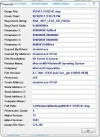moonknightfan
New Member
- Joined
- Oct 2, 2012
- Messages
- 6
- Thread Author
- #1
Hello,
I will try to be as detailed about my problem as possible.
While browsing using Chrome I received frequent recurring unresponsive warnings, followed by screen corruption/artifacting, followed by my first BSod (In 7). Attached to this post is a screenshot of the DMB File as detected by BlueScreenView. I also have the W7F Diagnostic attached. After the forced reboot, my computer wouldn't post. Nothing came on the monitor, no beeps were heard. I attached a second monitor, which didn't solve the problem. Fearing hardware failure, I unplugged my computer and detached the easy stuff first: Optical drives and my Sata HD's. After which my computer posted. I then systematically plugged the devices back in to find out which was the culpret. However, I was able to successfully plug all of them back in and the computer posted fine (very weird).
I then booted into Windows 7 Safe mode. I ran a Full Norton Scan, CCleaner, TDSSKiller, Malware Bytes, and Even checked through a HiJack this logfile. None of them found any suspicious files (I still fear a virus). I then Ran the Windows Memory Diagnostics, which found no problems either.
I then booted back into regular mode and updated my drivers (as I read online that can be a problem). The only out of date drivers were my network card and Video Card. After updating these, I found a problem in the Device Manager with AODDriver 4.1. It says the Device is not present or not working properly.
Games and programs in Windows 7 run noticabbly worse now. I also notice occasional slow down periods that are intermittent. I see nothing obvious in the taskmanager taking up resources.
Worst of all, however, is that when my PC boots now, it goes to a white curser before loading into windows. This curser flashes for a while, and drops down 4 lines after a few moments. After which, the windows 7 loading screen comes back.
I attempted to fix this in the Windows Recover mode (pressing F8 during boot). However this ran into problems. When running the Startup Repair, it errored saying Hard Disk Could Not Be Found. When I ran the Command prompt and typed BootRec.exe /FixMbr it errored saying Device Not ready.
What could be the issue here? Are there any other software scans I should run to ensure There isn't a vicious virus messing with my computer? What could have gone wrong? Is this a hardware issue that I can't seem to understand? I really appreciate your time. Thanks!
My PC Specs:
Windows 7 64Bit
AMD Phenom II X4 965
8GB Ram
1TB Raid (2x 1TB HD's Data Security RAID)
MSI Motherboard MS-7577
I will try to be as detailed about my problem as possible.
While browsing using Chrome I received frequent recurring unresponsive warnings, followed by screen corruption/artifacting, followed by my first BSod (In 7). Attached to this post is a screenshot of the DMB File as detected by BlueScreenView. I also have the W7F Diagnostic attached. After the forced reboot, my computer wouldn't post. Nothing came on the monitor, no beeps were heard. I attached a second monitor, which didn't solve the problem. Fearing hardware failure, I unplugged my computer and detached the easy stuff first: Optical drives and my Sata HD's. After which my computer posted. I then systematically plugged the devices back in to find out which was the culpret. However, I was able to successfully plug all of them back in and the computer posted fine (very weird).
I then booted into Windows 7 Safe mode. I ran a Full Norton Scan, CCleaner, TDSSKiller, Malware Bytes, and Even checked through a HiJack this logfile. None of them found any suspicious files (I still fear a virus). I then Ran the Windows Memory Diagnostics, which found no problems either.
I then booted back into regular mode and updated my drivers (as I read online that can be a problem). The only out of date drivers were my network card and Video Card. After updating these, I found a problem in the Device Manager with AODDriver 4.1. It says the Device is not present or not working properly.
Games and programs in Windows 7 run noticabbly worse now. I also notice occasional slow down periods that are intermittent. I see nothing obvious in the taskmanager taking up resources.
Worst of all, however, is that when my PC boots now, it goes to a white curser before loading into windows. This curser flashes for a while, and drops down 4 lines after a few moments. After which, the windows 7 loading screen comes back.
I attempted to fix this in the Windows Recover mode (pressing F8 during boot). However this ran into problems. When running the Startup Repair, it errored saying Hard Disk Could Not Be Found. When I ran the Command prompt and typed BootRec.exe /FixMbr it errored saying Device Not ready.
What could be the issue here? Are there any other software scans I should run to ensure There isn't a vicious virus messing with my computer? What could have gone wrong? Is this a hardware issue that I can't seem to understand? I really appreciate your time. Thanks!
My PC Specs:
Windows 7 64Bit
AMD Phenom II X4 965
8GB Ram
1TB Raid (2x 1TB HD's Data Security RAID)
MSI Motherboard MS-7577
